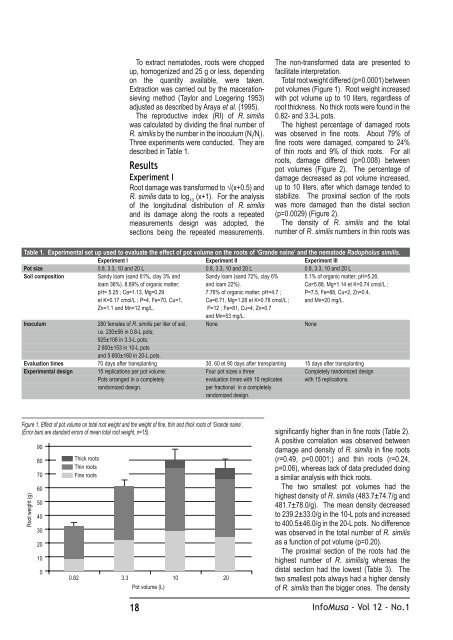Château-Musa - Bioversity International
Château-Musa - Bioversity International
Château-Musa - Bioversity International
You also want an ePaper? Increase the reach of your titles
YUMPU automatically turns print PDFs into web optimized ePapers that Google loves.
Table 1. Experimental set up used to evaluate the effect of pot volume on the roots of ‘Grande naine’ and the nematode Radopholus similis.<br />
Experiment I Experiment II Experiment III<br />
Pot size 0.8, 3.3, 10 and 20 L 0.8, 3.3, 10 and 20 L 0.8, 3.3, 10 and 20 L<br />
Soil composition Sandy loam (sand 61%, clay 3% and Sandy loam (sand 72%, clay 6% 5.1% of organic matter; pH=5.26;<br />
loam 36%). 8.69% of organic matter; and loam 22%). Ca=5.88, Mg=1.14 et K=0.74 cmol/L ;<br />
pH= 5.25 ; Ca=1.13, Mg=0.29 7.76% of organic matter; pH=4.7 ; P=7.5, Fe=88, Cu=2, Zn=0.4,<br />
et K=0.17 cmol/L ; P=4, Fe=70, Cu=1, Ca=6.71, Mg=1.28 et K=0.78 cmol/L ; and Mn=20 mg/L.<br />
Zn=1.1 and Mn=12 mg/L. P=12 ; Fe=81, Cu=4, Zn=0.7<br />
and Mn=53 mg/L.<br />
Inoculum 280 females of R. similis per liter of soil, None None<br />
i.e. 230±56 in 0.8-L pots;<br />
925±106 in 3.3-L pots;<br />
2 800±153 in 10-L pots<br />
and 5 600±160 in 20-L pots.<br />
Evaluation times 70 days after transplanting 30, 60 et 90 days after transplanting 15 days after transplanting<br />
Experimental design 15 replications per pot volume. Four pot sizes x three Completely randomized design<br />
Pots arranged in a completely evaluation times with 10 replicates with 15 replications.<br />
randomized design. per fractional in a completely<br />
randomized design.<br />
Root weight (g)<br />
90<br />
80<br />
70<br />
60<br />
50<br />
40<br />
30<br />
20<br />
10<br />
Thick roots<br />
Thin roots<br />
Fine roots<br />
To extract nematodes, roots were chopped<br />
up, homogenized and 25 g or less, depending<br />
on the quantity available, were taken.<br />
Extraction was carried out by the macerationsieving<br />
method (Taylor and Loegering 1953)<br />
adjusted as described by Araya et al. (1995).<br />
The reproductive index (RI) of R. similis<br />
was calculated by dividing the final number of<br />
R. similis by the number in the inoculum (N f /N i ).<br />
Three experiments were conducted. They are<br />
described in Table 1.<br />
Results<br />
Experiment I<br />
Root damage was transformed to √(x+0.5) and<br />
R. similis data to log 10 (x+1). For the analysis<br />
of the longitudinal distribution of R. similis<br />
and its damage along the roots a repeated<br />
measurements design was adopted, the<br />
sections being the repeated measurements.<br />
Figure 1. Effect of pot volume on total root weight and the weight of fine, thin and thick roots of ‘Grande naine’.<br />
(Error bars are standard errors of mean total root weight, n=15).<br />
<br />
0<br />
0.82 3.3 10 20<br />
Pot volume (L)<br />
18<br />
The non-transformed data are presented to<br />
facilitate interpretation.<br />
Total root weight differed (p=0.0001) between<br />
pot volumes (Figure 1). Root weight increased<br />
with pot volume up to 10 liters, regardless of<br />
root thickness. No thick roots were found in the<br />
0.82- and 3.3-L pots.<br />
The highest percentage of damaged roots<br />
was observed in fine roots. About 79% of<br />
fine roots were damaged, compared to 24%<br />
of thin roots and 9% of thick roots. For all<br />
roots, damage differed (p=0.008) between<br />
pot volumes (Figure 2). The percentage of<br />
damage decreased as pot volume increased,<br />
up to 10 liters, after which damage tended to<br />
stabilize. The proximal section of the roots<br />
was more damaged than the distal section<br />
(p=0.0029) (Figure 2).<br />
The density of R. similis and the total<br />
number of R. similis numbers in thin roots was<br />
significantly higher than in fine roots (Table 2).<br />
A positive correlation was observed between<br />
damage and density of R. similis in fine roots<br />
(r=0.49, p=0.0001;) and thin roots (r=0.24,<br />
p=0.06), whereas lack of data precluded doing<br />
a similar analysis with thick roots.<br />
The two smallest pot volumes had the<br />
highest density of R. similis (483.7±74.7/g and<br />
481.7±78.0/g). The mean density decreased<br />
to 239.2±33.0/g in the 10-L pots and increased<br />
to 400.5±46.0/g in the 20-L pots. No difference<br />
was observed in the total number of R. similis<br />
as a function of pot volume (p=0.20).<br />
The proximal section of the roots had the<br />
highest number of R. similis/g whereas the<br />
distal section had the lowest (Table 3). The<br />
two smallest pots always had a higher density<br />
of R. similis than the bigger ones. The density<br />
Info<strong>Musa</strong> - Vol 12 - No.1

















